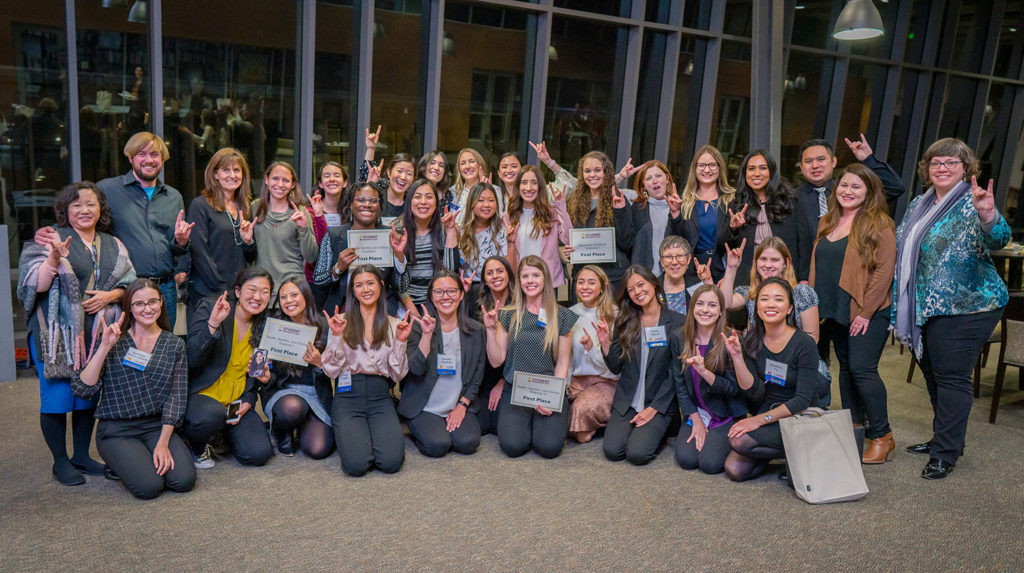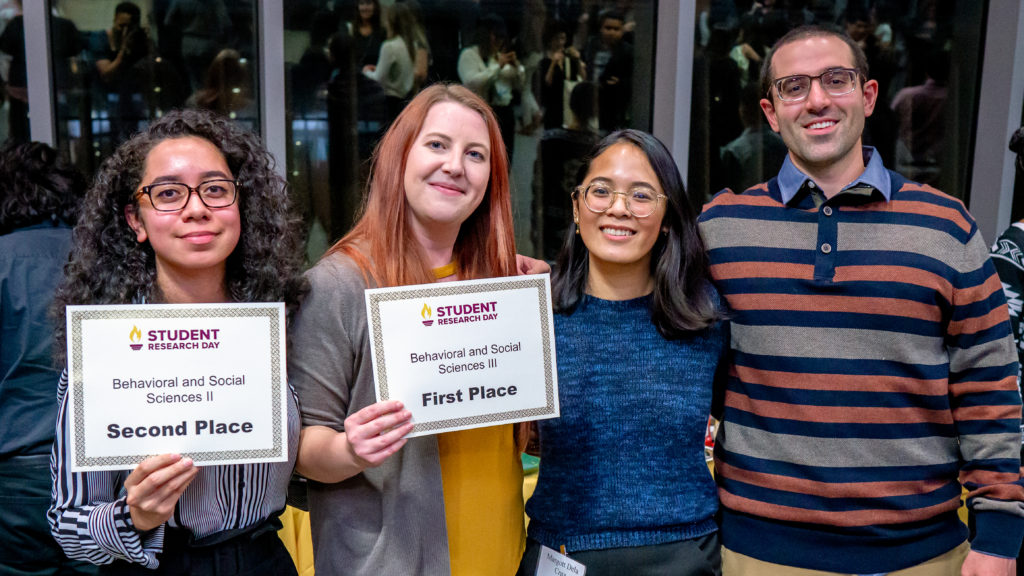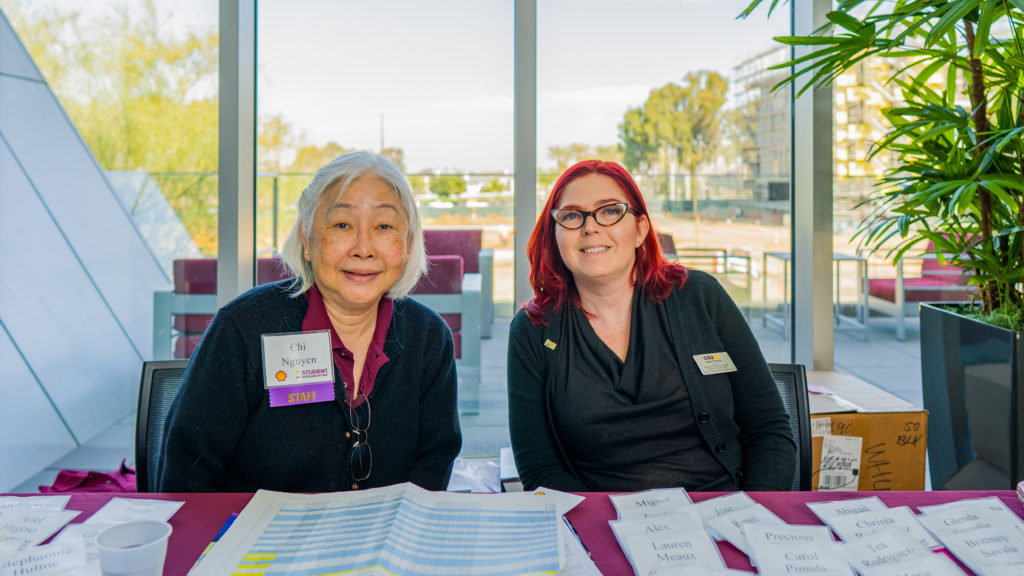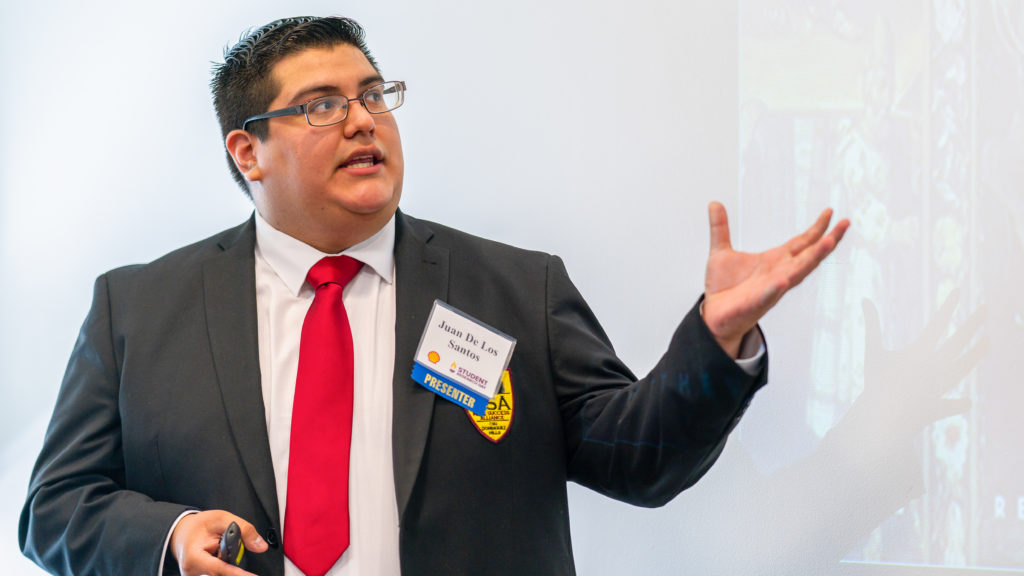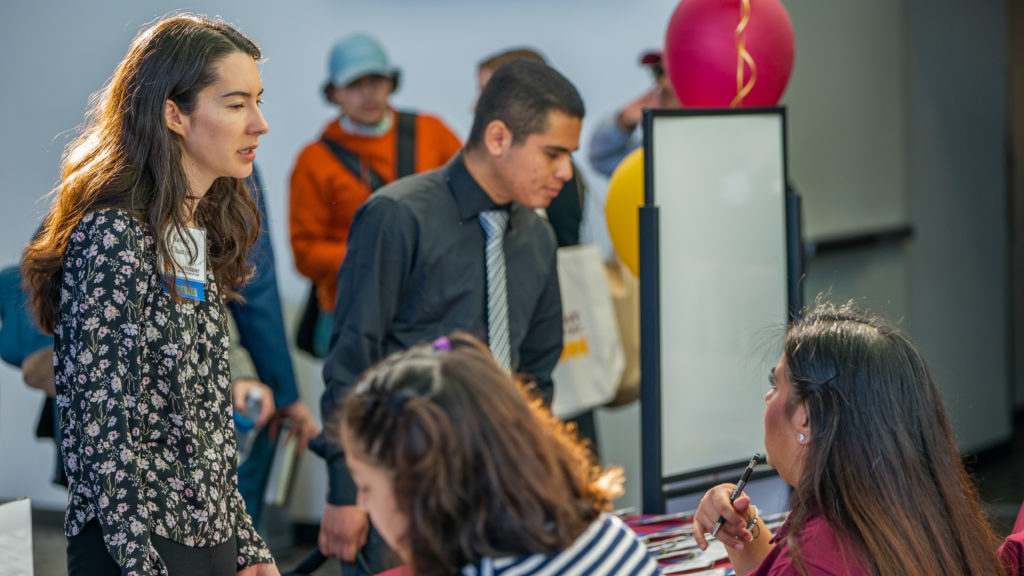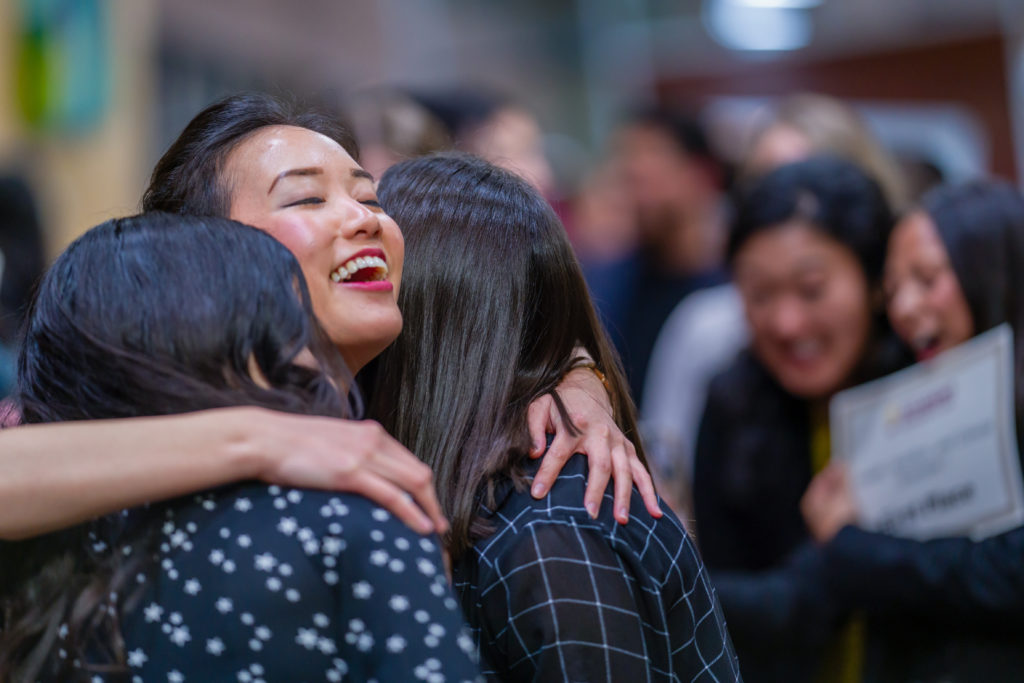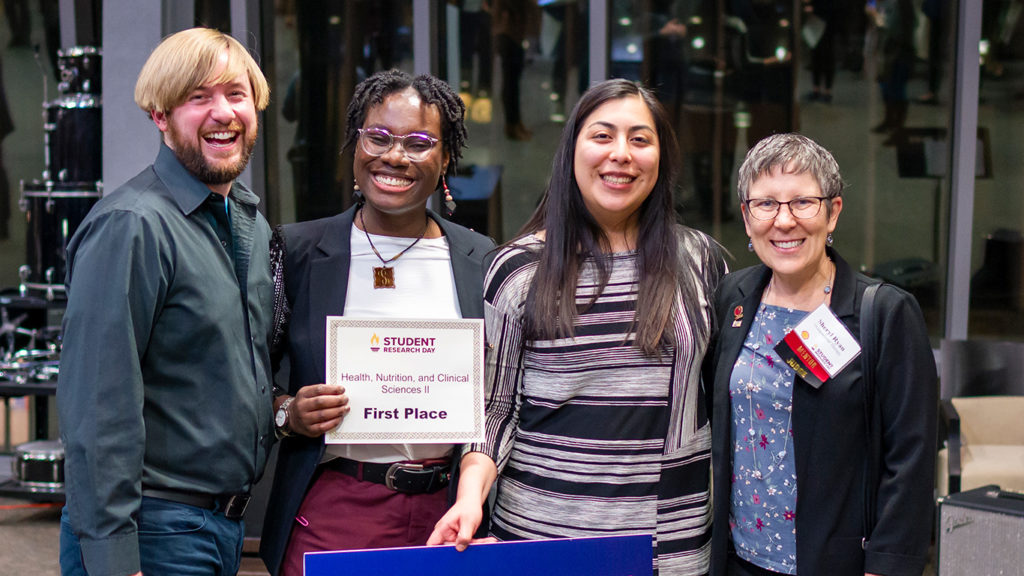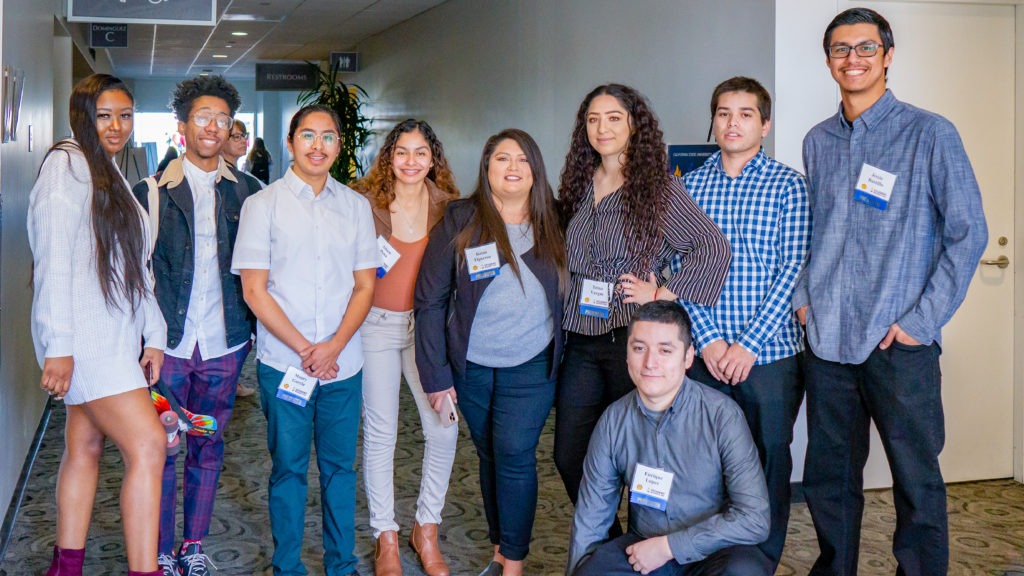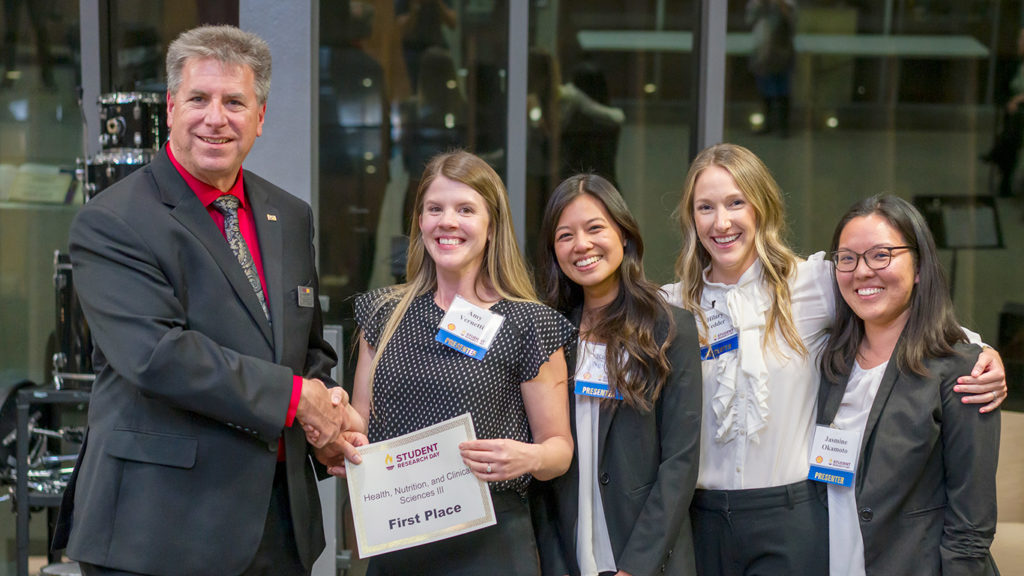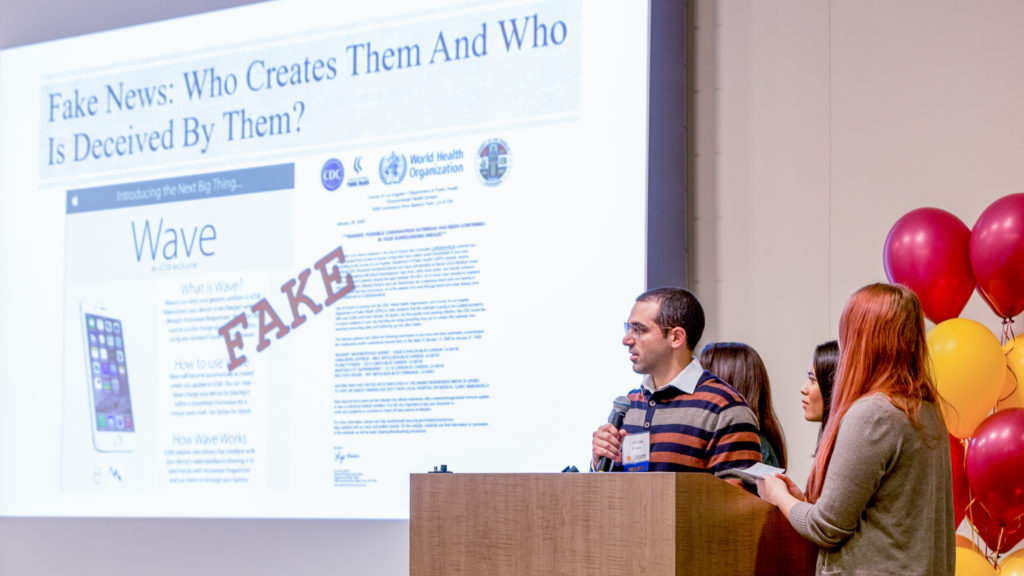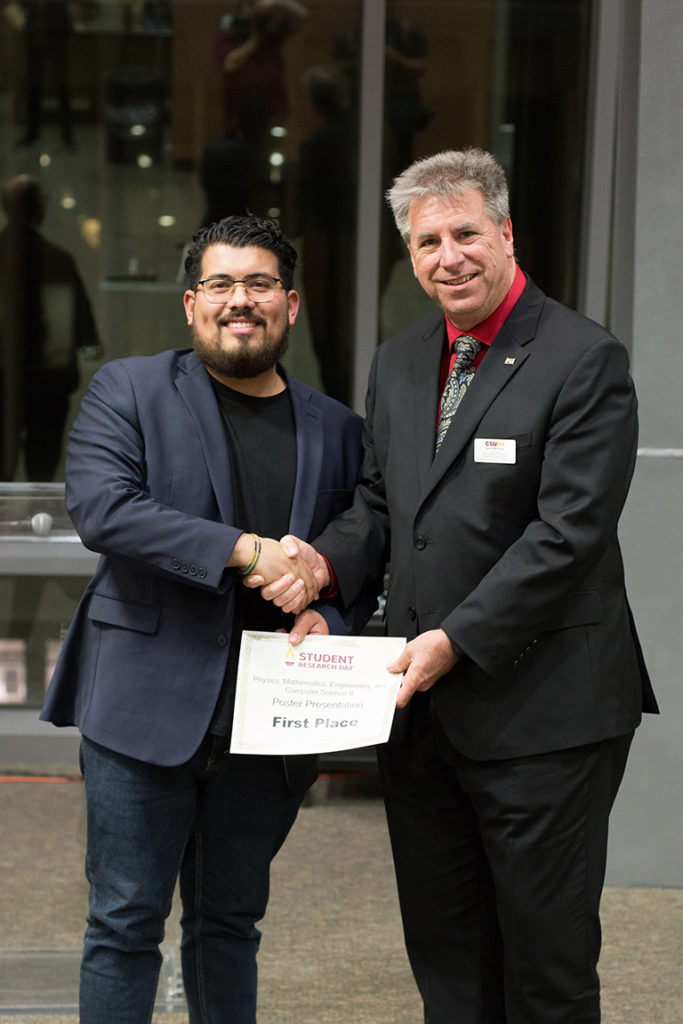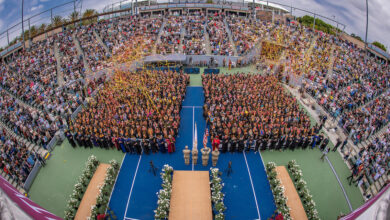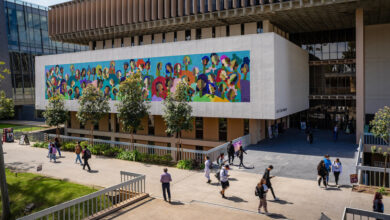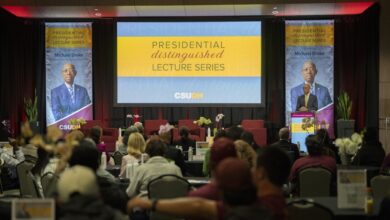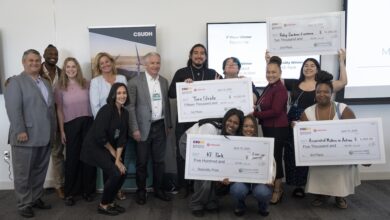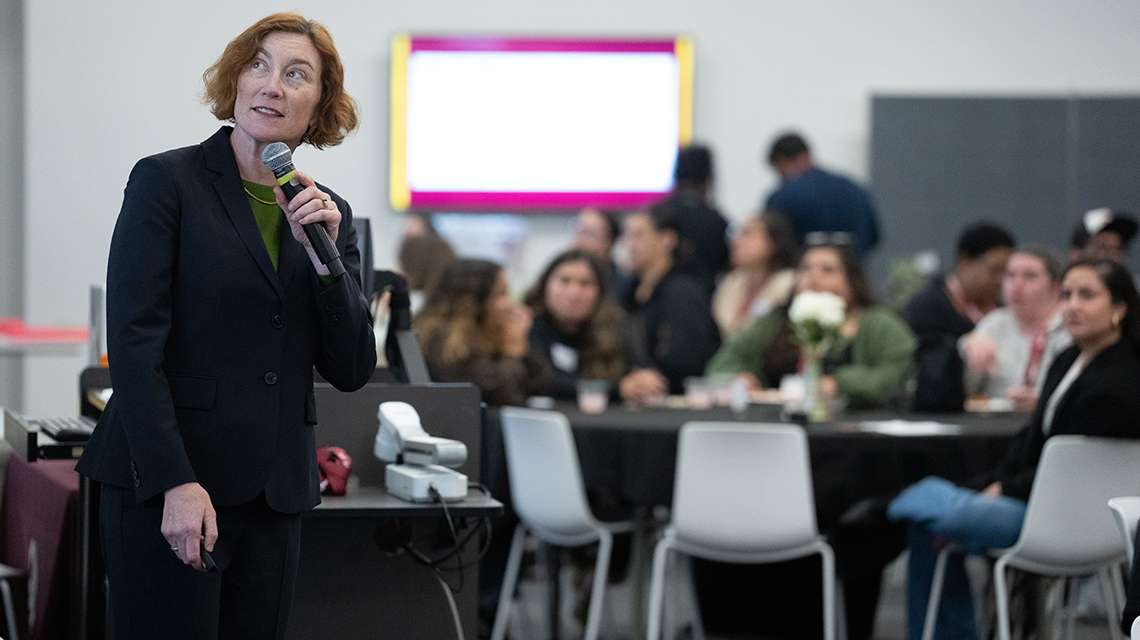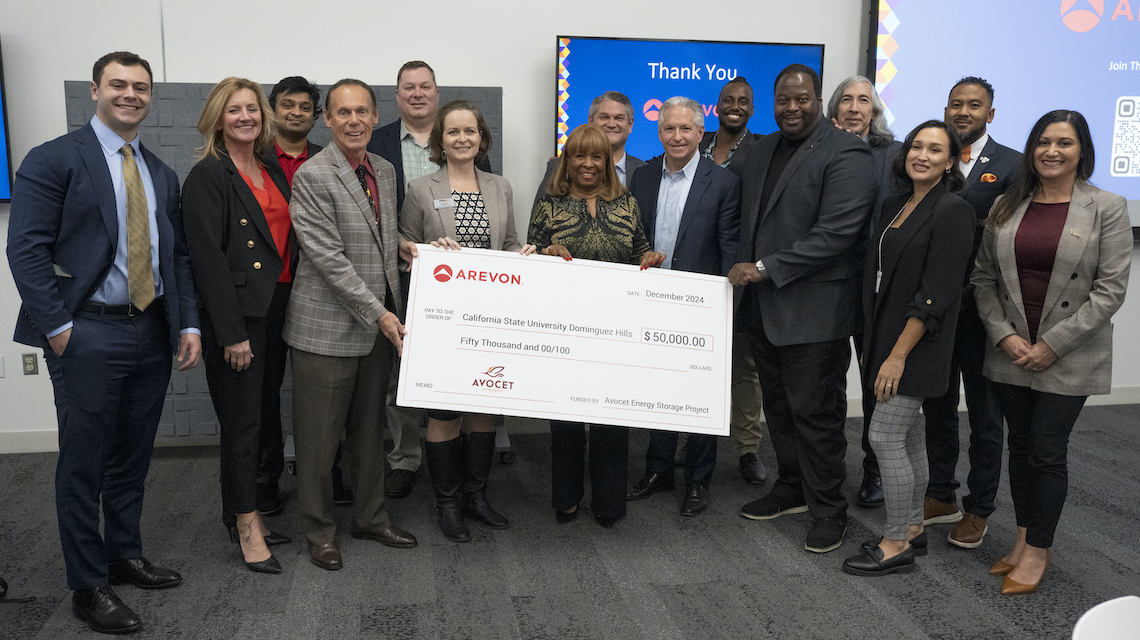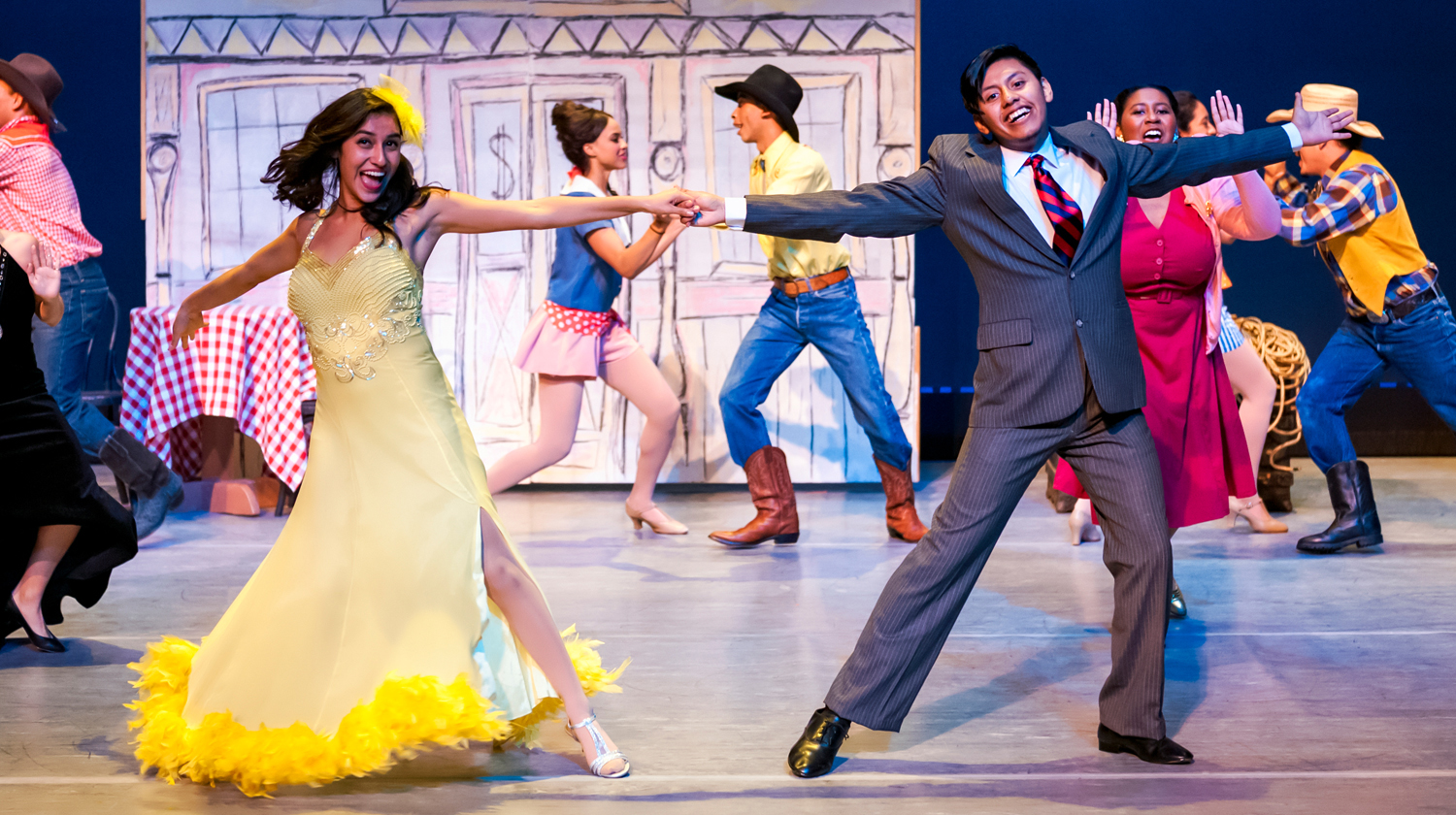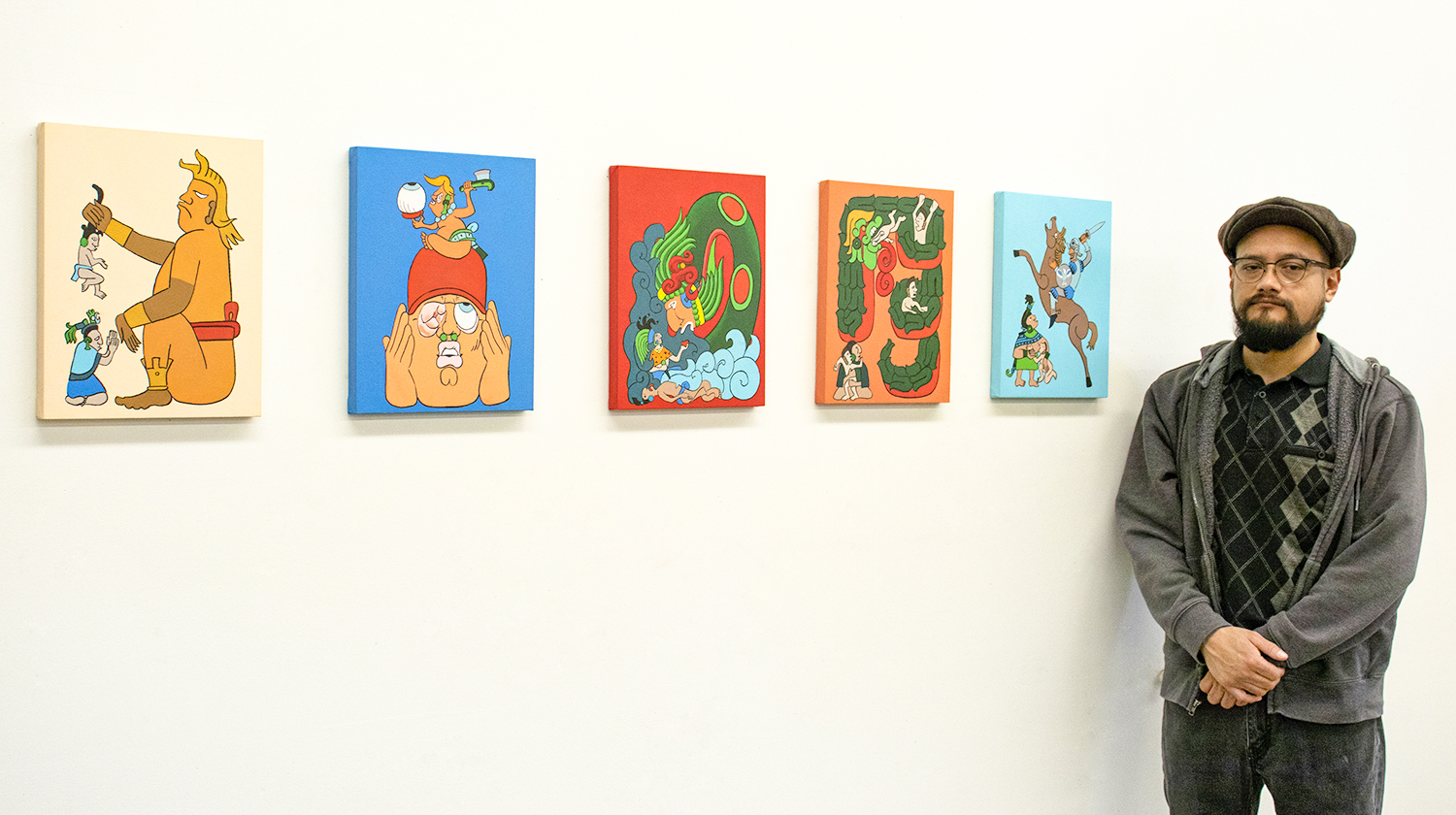
Nearly three dozen students received top honors for their scholarly research and creative activity during California State University, Dominguez Hills’ (CSUDH) 15th Annual Student Research Day (SRD) competition on Feb. 12 and 13.
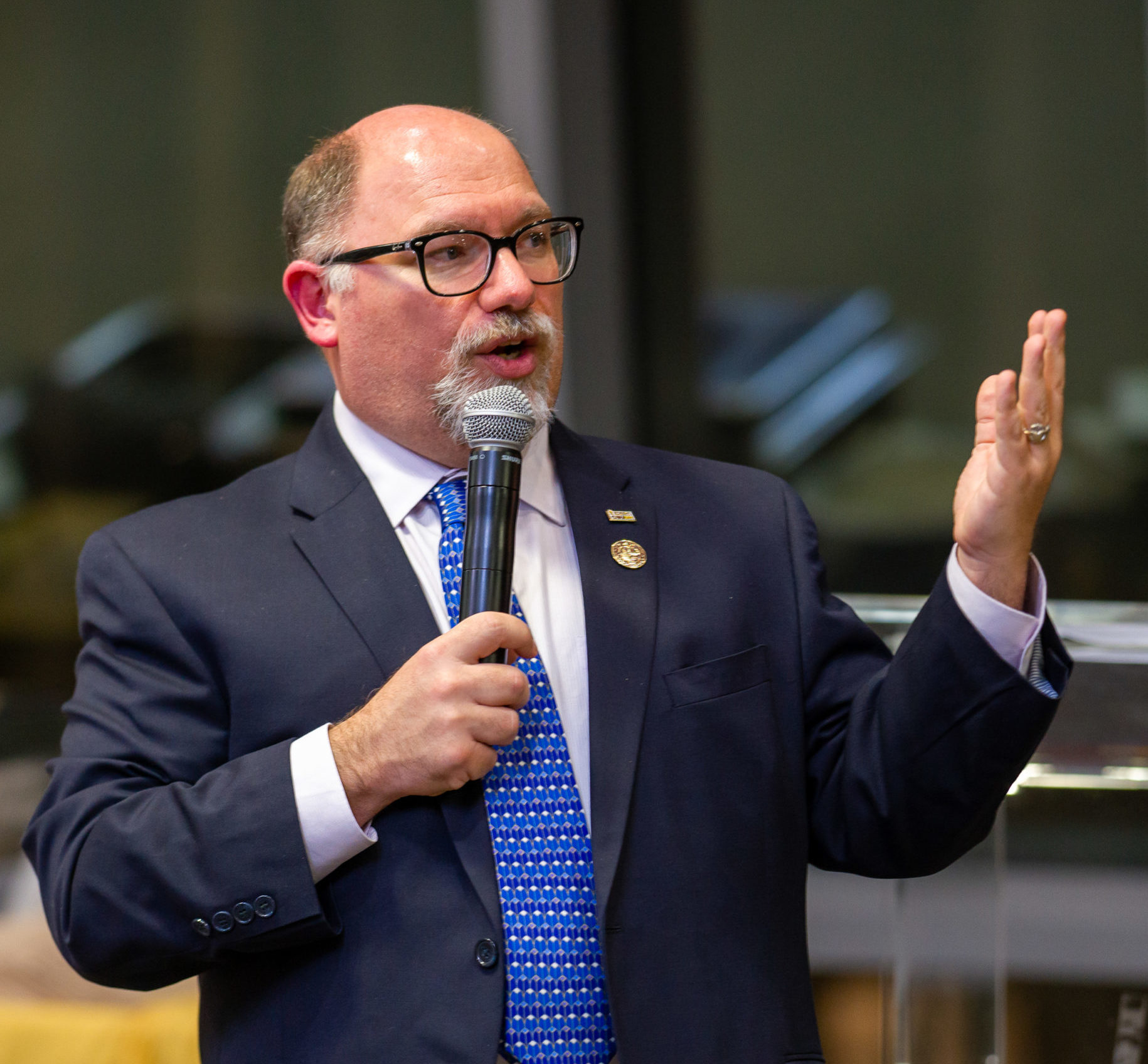
Since 2005, the highly anticipated showcase of comprehensive faculty mentorship and student achievement has brought together the campus community, and an enthusiastic group of volunteers.
This year, 110 faculty mentors guided the nearly 400 students who delivered oral and poster presentations during SRD, while 96 judges evaluated the students’ research in a wide range of academic disciplines, from history to health, business to biology, Chicana/o studies to computer science.
“Student Research Day is special for us at CSUDH because we bring together students from all of our academic disciplines to share the original discoveries that they are contributing to the field,” said Terry McGlynn, professor of biology and director of undergraduate research, who served as chair of the 18-member SRD Organizing Committee. “As more faculty on campus are engaging with undergraduates in research, inside and beyond the classroom, we continue to see growth in the quantity and impact of the student research.”
From CSUDH’s winning pool, 10 student researchers will be selected to represent the university at the statewide 2020 CSU Research Competition on April 24-25 at CSU East Bay. Visit the competition webpage for more information.
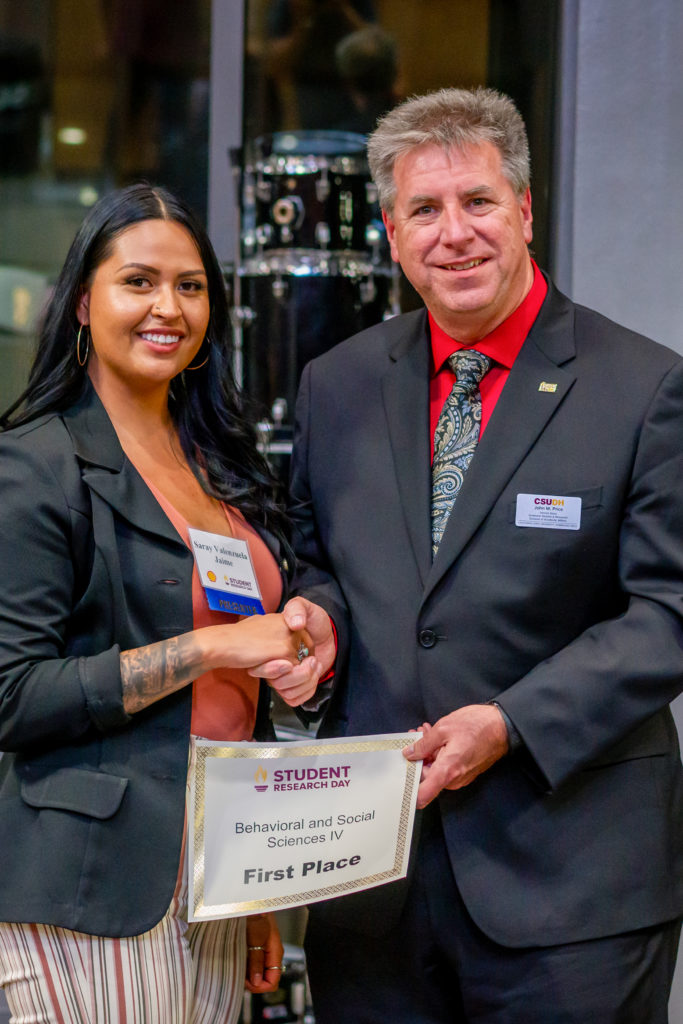
Saray Valenzuela Jaime placed first in the Behavioral and Social Sciences IV category for her research, “A Mindful Approach to Improving Work Performance among College Students.” Her faculty mentor is Kevin Montes, assistant professor of psychology.
Most research on this topic has been narrowly focused on the relationship between mindfulness and emotions, according to Jaime. Instead, she surveyed CSUDH students to discover if emotions mediate the relationship between mindfulness and productivity, if mindfulness causes lower levels of negative emotions, and if it could be used to foster better work productivity.
“You’ll often read in the news about the increase of college students seeking psychological services. The demand for these services is high everywhere, even on our campus,” she said. “Students may be placed on long waiting lists to speak to a psychological counselor, which can be detrimental for those suffering from anxiety, depression, and other negative issues.”
“Most students experienced some type of psychological issue during their college careers,” said Jaime, who plans to pursue a career in industrial organizational psychology, with a more specific focus in subfield of occupational health psychology. “We focus so much on the ultimate outcome of going to college–receiving a degree or a Ph.D.–but we don’t often look at the process of getting there. It can be very draining.”
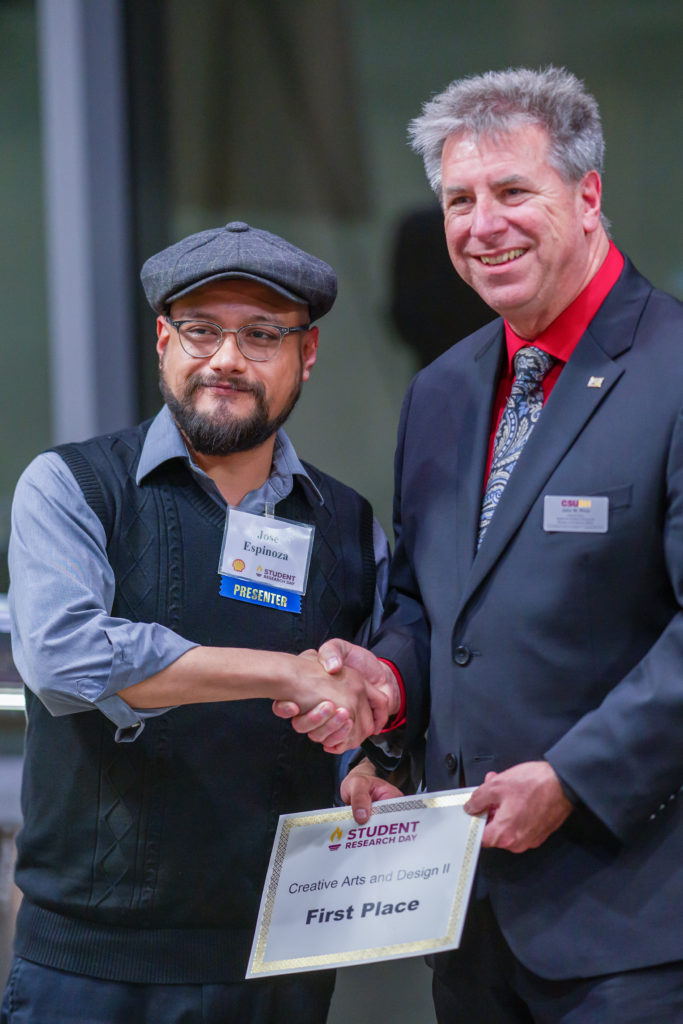
Studio arts major Jose Espinoza earned first place in the Creative Arts and Design II category for his art presentation “Illustrating Historical Truth through Visual Research.” His SRD mentor is Devon Tsuno, assistant professor of art and design.
Espinoza has always been fascinated with history, and believes that stories found in history books are often not accurate. His work reflects the colonization of Mesoamerica that began in the 1500s, drawing attention to the “imprisonment of the descendants of the Mesoamericans” being detained at the U.S.-Mexico border today.
“Winston Churchill famously said, ‘History is written by victors.’ When you look at history– not written history, the actual art history of a culture–you find that truth is illustrated there,” said Espinoza. “Since there hasn’t been an honest account of what’s going on at the border with families being separated and locked up, I am trying to help provide a visual representation of true history for future generations.”
Espinoza’s long-term goal is to show his work in galleries, and to “stop being a spectator” and become entrenched in the art community.
Erik Martinez, a cellular and molecular biology student, placed second in the Biological and Agricultural Sciences II category. Under the direction of his faculty mentor Associated Professor of Biology Karin Kram, Martinez studies the evolution of E. coli bacteria, testing for essential genes in long term survival by cultivating them over a long period of time, and recording the subsequent gene mutations that have an effect in the long-term stationary phase of its life.
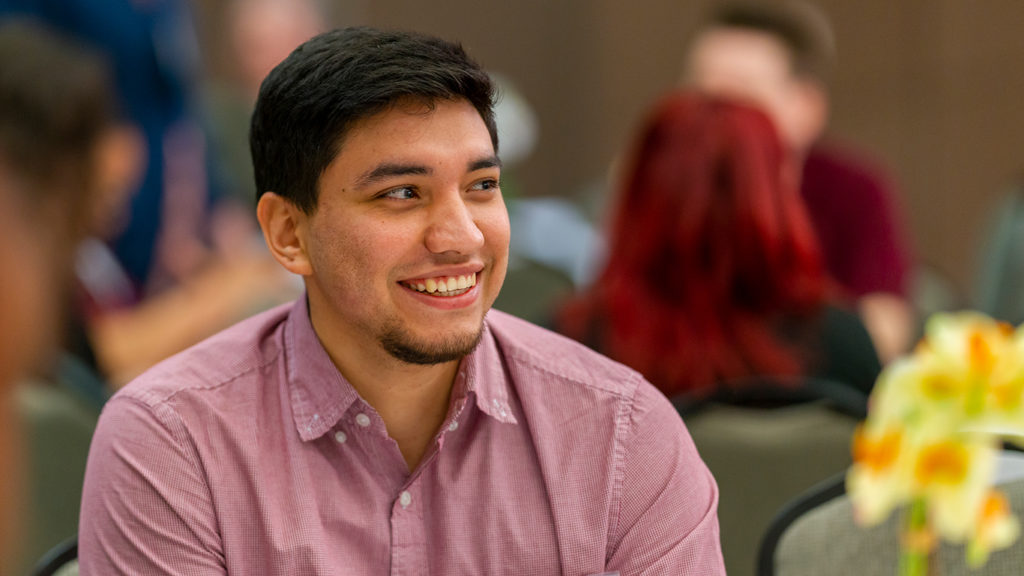
Martinez, who plans to pursue a Ph.D. and continue his research in pathogenic bacteria as a career, hopes his findings will help other researchers expand their work on E. coli.
“There hasn’t been a lot of time dedicated to researching the long-term stationary phase of E. coli, which is in the later stages of its life cycle. This stage reflects more of the natural environment of E. coli,” said Martinez. “We have identified 102 different genes in this stage that may play a role in E. coli’s long-term survival, but we’re still confirming if all these genes have an affect on the cell.”
2020 Student Research Day Winners
Oral Presentations
Behavioral and Social Sciences I
First Place: Mary Gauthier, Elijah Arzate. “Using the Theory of Planned Behavior and Procedural Justice Theory to Assess the Intent to Report Crime.” Faculty Mentor: Heather Butler
Second Place: Kresh Reil, Michelle Ruvalcaba, Tiffany Conejo, Leticia Estrada, Tania Salgado Gonzalez, Sara Sosa. “Manipulating Resilience in an Everyday Setting: The Effects of Self-Efficacy Priming and Social Support.” Faculty Mentor: Steven Frieze
Behavioral and Social Sciences II
First Place: Cassie Mingoia, Kallie Miller, Elisabeth Lawson. “Maneuvering the Minefield: The Lived Experience of Dating for Individuals with Congenital Disabilities.” Faculty Mentor: Sheryl Ryan.
Second Place: Ryan Butler, Stephanie Torres, Yoslin Caro. “Can Google Cardboard’s Virtual Reality Platform Aid in Learning and Memory?” Faculty Mentor: Larry Rosen.
Behavioral and Social Sciences III
First Place: Margott Dela Cruz, Gabrielle Makrdichian, Yadira Ramirez, Ceferino Vinas. “www.fakenews.you: Cognition’s Influence on People’s Reactions to False Internet Information.” Faculty Mentor: Mark Carrier
Second Place: Violet Quann, Eva Levingston, Jason Hawes. “Effects of General Self-Efficacy on the Stress-Sleep Relationship.” Faculty Mentor: Erin Merz.
Behavioral and Social Sciences IV
First Place: Saray Valenzuela Jaime. “A Mindful Approach to Improving Work Performance among College Students.” Faculty Mentor: Kevin Montes.
Second Place: Bonnie Perez.” The Influence of Cultural Differences in Attention: A Study on Preschool Children Books.” Faculty Mentor: Megumi Kuwabara.
Biological and Agricultural Sciences I
First Place: Alondra Pena. “Adverse effects of In Utero exposure to E-cigarette and High Fat Diet on Fetal Hearts.” Faculty Mentor: Kamrul Hasan (Charles Drew University).
Second Place: Diane Aguilar, Patino Romero. “Investigating Protein-Protein Interactions in the Chp Chemosensory System of Pseudomonas aeruginosa. Faculty Mentor: Joanne Engel (UC San Francisco).
Biological and Agricultural Sciences II
First Place: Ann Lobo. “Assessing the function of genes involved in aromatic compound metabolism in Escherichia coli survival.” Faculty Mentor: Karin Kram.
Second Place: Erik Martinez. “Identifying Gene’s essential to E. coli in long term stationary phase.” Faculty Mentor: Karin Kram.
Business, Economics, and Public Administration
First Place: Lisa Vihlborg. “Generations and Influencer Marketing.” Faculty Mentor: Orie Berezan.
Second Place: Michael Aguilera. “Revealing the hidden risks in gig work: From the perspective of Uber and Lyft drivers.” Faculty Mentor: Nancy Deng.
Creative Arts and Design I
First Place: Sandra Lopez, Aileen Pena, Jessie Bustillo, Sandra Lopez, and Elexus Gilliam. “Street Takeover.” Faculty Mentor: George Vinovich.
Second Place: Trina Vargas, Aileen Pena.” Smartphone Addiction.” Faculty Mentor: George Vinovich.”
Creative Arts and Design II
First Place: Jose Espinoza.” Illustrating Historical Truth Through Visual Research.” Faculty Mentor: Devon Tsuno.
Second Place: Brianna Correa. “Curvaceous Beauty.” Faculty Mentor: Greg Mocilnikar
Education
First Place: Kaitlyn Pardo. “Sometimes I Just Want to Lie on the Floor and Do Nothing: Mindfulness Practices in a 5th Grade Classroom.” Faculty Mentor: Edward Curammeng.
Second Place: Kristian Kennedy “I don’t get it!”: Culture, Classrooms, and Cultivating Student Engagement Faculty Mentor: Edward Curammeng
Engineering and Computer Science
First Place: Aishwarya Murkute, Aditya Lalchandani Parking. “Lot Detecting.” Faculty Mentor: Bhrigu Celly.
Second Place: Jaspreet Singh Jaspreet “Redundancy Check.” Faculty Mentor: Bin Tang.
Health, Nutrition, and Clinical Sciences I
First Place: Ciara Nagao, Kelsey Santos, Madison Werchowsky. “Experiences of Occupational Therapists Working with High-Needs, High-Risk Youth.” Faculty Mentor: Heather Kitching.
Second Place: Ashley Mooney. “Success Rates of Cranial Remolding Orthoses in Male vs. Females in Cases of Brachycephaly.” Faculty Mentor: Jennifer LuÄarević.
Health, Nutrition, and Clinical Sciences II
First Place: Amy Vernetti, Hilary Vedder, Kathy Nguyen, Jasmine Okamoto.”Through the lens of veterans with symptoms of Post-Traumatic Stress Disorder (PTSD): The impact on perceived quality of life.” Faculty Mentor: Heather Kitching.
Second Place: Brianna Heath. “Measuring Proprioception Changes in Transtibial Amputees.” Faculty Mentor: Jennifer LuÄarević
Health, Nutrition, and Clinical Sciences III
First Place: Elvy Fuentes, Josiah Gibson, Rebecca Hawkinson Gonzalez, Thelma Iwuchukwu.”The Experience of Participants in a Community-Based Arts Center. “Faculty Mentor: Sheryl Ryan.
Second Place: Monique Sanchez, Micaella Salunga, Jocelinne Torres-Lizarde, Michelle J. Wong. “The Lived Experiences of Survivors of SCI After a Separation.” Faculty Mentor: Heather Kitching.
Humanities and Letters I
First Place: Bailey Britton. “Analysis of Stephen Colbert’s 2006 White House Correspondents’ Association Dinner Speech with Politeness Theories.” Faculty Mentor: Vanessa Wenzell.
Second Place: Orji Ezieme. “Dual EPA Superfund Sites: A Community Cries for Justice and Safety Out for Justice and Safety.” Faculty Mentor: Margaret Manning.
Humanities and Letters II
First Place: Bryan Cantero. “Mexican (American) Corridista students: Resisting educational oppression through Corridos Faculty.” Mentor: Corina Benavides Lopez.
Second Place: Porscha Singh. “Oh No You Didn’t!”: Understanding Sapphireness and Unpacking Media Essentializing of the Angry Black Woman Trope in Television.” Faculty Mentor: Ryan Bowles Eagle.
Humanities and Letters III
First Place: Roberto Ortega. “Empowerment Through Ancestral Roots.” Faculty Mentor: Marisela Chavez.
Second Place: Makonnen Tendaji. “Poetry, Power, and Pistols: Analyzing the Cultural Consumption of Black Male Trauma Expressed in Hip-Hop.” Faculty Mentor: Donna Nicol.
Physical and Mathematical Sciences
First Place: Omar Santizo, Claire Ladan, Justin Hathaway. “Hacking Electrochemistry: Improving Undergraduate Chemistry Education Analyzing Biochemical Redox Analytes Using a Student-Built Potentiostat. “Faculty Mentor: Barbara Belmont.
Second Place: Stephanie Gaston. “An Average of Generalized Dedekind Sums.” Faculty Mentor: Matthew Young (Texas A&M).
Poster Presentations
Behavioral and Social Sciences, Session I
First Place: Michelle Sov, Ana De La Torre, and Elizabeth Mallonnee. “Integrating Community Engagement in CSUDH’s General Education Program.” Faculty Mentor: Sarah Taylor.
Behavioral and Social Sciences, Session II
First Place: Tania Lugo, Stacy Zamora, Peter Jerome, and Ishmael Paulino. “Chronic administration of ethanol and the brain: a role for ΔFosB?” Faculty Mentor: Philip Vieira.
Biological and Agricultural Sciences
First Place: Jocelyn Molina-Mancio. “Metabolic Changes in Adipose Tissue in Response to Chronic Electronic Cigarette Exposure .” Faculty Mentor: Jorge Espinoza-Derout (Charles Drew University).
Business, Economics, Creative Arts, Education, and Computer Science
First Place: Nicole Santillan. “Applying Community Cultural Wealth into Classrooms: An Ethnographic Study Examining Cultural Wealth in the City of Gardena.” Faculty Mentor: Jen Stacy.
Health, Nutrition, and Clinical Sciences, Session I
First Place: Ashley Mooney. “Success Rates of Cranial Remolding Orthoses in Male vs. Females in Cases of Brachycephaly.” Faculty Mentor: Jennifer LuÄarević.
Health, Nutrition, and Clinical Sciences, Session II
First Place: Rylie Weldon. “Changes in Self Selected Gait Speed with Visual and Vestibular Challenges.” Faculty Mentor: Julie Werner.
Physical and Mathematical Sciences, Session I
First Place: Jose Garfias, Nadia Hirbawi. “Theoretical Study of 3FC-TZN and its Host-Guest interaction in the Determination of Stable Electroactive Materials.” Faculty Mentor: Kenneth Rodriguez.
Physical and Mathematical Sciences, Session II
First Place: Elvis Carrillo. “A Story of California’s Seismic Hazards: Studying Historical and Simulated Earthquakes Through Geovisualization Platforms .” Faculty Mentor: Parveen Chhetri.
